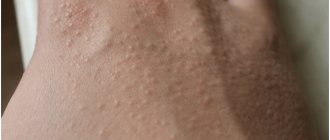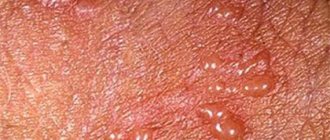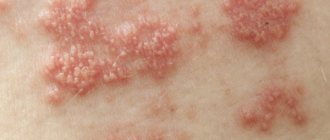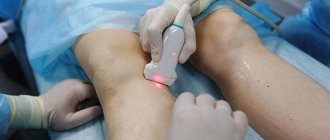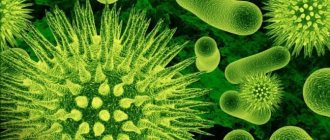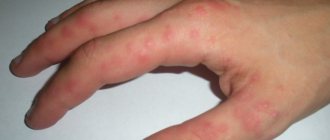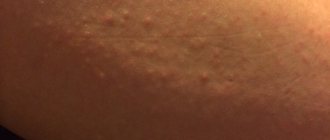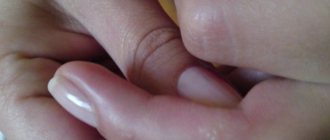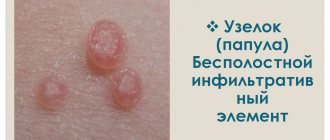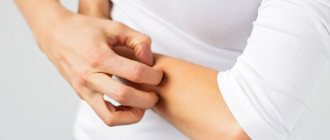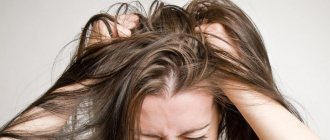Types of acne on the body
Despite the fact that the skin on the body is denser and has more powerful protective functions compared to the epidermis of the face, inflammatory elements often form on it. These can be either primary formations in areas of healthy epidermis, or secondary ones - appearing in place of the primary ones in the absence of treatment or under the influence of other negative factors. At the same time, pimples on the skin differ in external characteristics: shape, size, color, presence of contents, quantity. Let's look at some types of acne.
Watery acne on the body
These formations look like hemispherical vesicles rising above the skin, located in the tissues of the epidermis and containing a clear or slightly cloudy liquid inside. Their color can be either flesh-colored or red or pinkish. Water pimples on the body may indicate the following pathologies:
- Scabies
is a skin disease caused by the scabies mite, which initially manifests itself as itchy rashes in the form of nodules, at the next stage turning into blisters, often complicated by a bacterial infection. - Shingles
is a pathology caused by the activation of the varicella-zoster virus in the body and manifests itself as multiple pimples on the body on one side along the nerve trunk, preceded by pink edematous spots. - Pemphigus
is a rare, severe autoimmune disease, the symptom of which is a painful, watery rash of varying sizes throughout the body, which quickly opens and leaves behind erosions. - Dyshidrosis (dropsy)
- multiple pimples on the body with transparent light contents, which itch, open with the formation of painful cracks, the appearance of which is associated with disorders in the endocrine, nervous, and digestive systems. - Photodermatitis
is a reaction of skin tissue to solar radiation, manifested by watery pimples of various sizes against a background of redness, often accompanied by severe burning and itching.
Red pimples on the body
Pimples on the body, characterized by a red color, may appear as nodules or spots of varying sizes. In order to determine the origin of such a rash, it is important to take into account what factors the body has been under recently, what foods and medications have been taken, and what other associated symptoms are present. In most cases, this type of rash is associated with the following diseases:
- Scabies
- if red pimples on the body itch, and the intensity of the itching intensifies in the evening and at night, this may indicate damage to the epidermis by scabies mites, which are most often infected through close direct contact with a sick person. - Allergy
is a reaction to external and internal irritants (food, medicine, dust, synthetic fabrics, cosmetology and household chemicals, jewelry, etc.). - Syphilis
- one of the manifestations of this sexually transmitted disease is a chaotically located painless rash on the body, which at different stages can look like reddish spots, small pinkish-red or bluish bumps, dense purple bumps. - Bacterial meningitis
- with inflammation of the membranes of the brain and spinal cord caused by meningococci, a bright red nodular rash may appear at an early stage, protruding above the skin and not disappearing with pressure. - Infectious endocarditis
- this disease affects the tissue of the heart valve and, as one of the manifestations, may have red pimples that do not fade when pressed, subsequently acquiring a brownish tint. - Hemorrhagic vasculitis
is an aseptic inflammation of the walls of skin vessels with multiple microthrombosis, which can be a complication of some microbial pathologies. - “Children’s” infectious diseases
– measles, rubella, scarlet fever, chickenpox.
White pimples on the body
Often, rashes that have a white or whitish-yellow “head” and are characterized by pain are purulent acne on the body. Such elements appear during infectious and inflammatory processes in tissues; they are filled with cloudy exudate that comes out when pressed. The occurrence of pustular pimples can be caused by the following main factors:
- Attachment of a secondary bacterial infection
due to injury or improper care of existing primary rashes (pus is formed as a result of the activity of pathogenic microorganisms). - Folliculitis
is an inflammation of the hair follicle with the formation of a red spot or nodule around the hair on the skin, from which a purulent pimple soon forms. - A furuncle
is a purulent-inflammatory formation that covers the hair follicle, the sebaceous gland and an area of connective tissue, often caused by the activity of Staphylococcus aureus. - Acne (pimples)
are pimples on the body, the appearance of which is largely associated with excess fat formation in the skin's sebaceous glands and a disruption in the process of keratinization of the epithelium.
Large pimples on the body
Large rashes are often deep, affecting not only the epidermis, but also the lower layers of the skin. Such acne on the body is painful, the tissue around it is characterized by swelling and redness. Special care must be taken with them, because given the infectious nature of such acne, there is a high probability of pathogenic microbes spreading throughout the body. After the disappearance of such elements, scars and areas of hyperpigmentation may remain.
Small pimples on the body
Small bumps or spots that appear can cause no less discomfort than large subcutaneous formations, because Often small pimples on the body itch, cause dryness or weeping of tissues, and are dangerous for infection with the development of purulent processes. In addition, a small rash is often a manifestation of dangerous and contagious diseases that require urgent treatment.
Acne on the body - the causes of what disease?
It is not always possible to determine why acne appears on the body through visual inspection alone. In many cases, this requires additional research, which includes:
- general blood and urine analysis;
- blood chemistry;
- blood test for sex hormones, thyroid hormones;
- ultrasound examination of the digestive organs;
- throat swab analysis;
- allergy tests, etc.
Common culprits of body acne include:
- changes in hormonal levels;
- disorders of digestive and metabolic processes;
- psychological and neurological problems;
- allergens;
- lack of proper hygiene;
- wearing low-quality synthetic clothing;
- infections.
Acne all over the body - causes
A rash in adults, distributed over the entire surface of the body, can indicate both infectious and non-infectious pathologies: allergies, blood and vascular diseases, acute and chronic infectious diseases transmitted by contact, airborne droplets, and sexual contact. Pathologies provoked by microorganisms (bacteria, viruses, fungi) are in many cases indicated by general intoxication symptoms: increased body temperature, weakness, headache, nausea.
Some people experience so-called cold pimples on the body - inflammatory bright red painful rashes affecting different areas of the body, associated with hypothermia of the body, decreased immune defense in the autumn-winter period. Athletes who take cold showers after intense training are prone to the appearance of such pimples.
Acne on legs
If the rash is localized on the lower extremities, the probable cause may be associated with allergic manifestations. Using low-quality washing powder, wearing nylon tights, or depilatory products can provoke an inadequate reaction. Often, acne on women's legs occurs when the skin is injured during shaving or due to ingrown hairs. If rashes are present on the feet, in the interdigital areas, this may indicate dyshidrosis or a fungal infection.
Pimples on hands
In people with sensitive skin, allergies in the form of acne on the body, especially on the upper extremities, are a common occurrence. In most cases, this is caused by contact with household chemicals, certain metals, and is provoked by exposure to low temperatures and dry air. The localization of the rash on the palms is characteristic of syphilis, on the hands and between the fingers - for eczema (multiple rashes tend to merge).
Acne on the stomach
If acne on the body itches, focusing in the abdominal area, this may be a manifestation of scabies, dermatosis, psoriasis, or herpes virus infection. Also, such pimples often indicate allergic dermatitis caused by the influence of foods, medications, and external irritants. In people who are prone to obesity, pimples on the stomach often appear in the hot season due to excessive sweating under tight clothing.
Acne on chest and back
In the upper part of the body, so-called hormonal acne can be localized - acne associated with an imbalance of sex hormones in the body. Some women are prone to such rashes almost throughout their lives, with exacerbations associated with the menstrual cycle. Similar formations in the back and chest area are possible with hypothermia, herpes zoster, and psoriasis.
Additional diagnostics
Although clinical examination is the leading method of diagnosis for many diseases, in some cases it is not possible to determine the origin of the rash without additional examination. If the doctor has doubts, he may refer the patient for laboratory tests:
- Hemogram (erythrocytes, leukocytes, eosinophils, platelets, ESR).
- Biochemical indicators (rheumatic tests, immunoglobulins, markers of liver function, hormones, glucose).
- Serological tests (ELISA, RIF, RSK).
- Skin allergy tests (application, scarification, injection).
- Scraping from elements of the rash (microscopy, culture).
- Molecular genetic tests (PCR).
If pathology of internal organs is suspected, it is recommended to undergo an ultrasound of the liver and intestinal endoscopy. A dermatologist, allergist, and infectious disease specialist will help your general practitioner formulate a complete picture of what is happening. If necessary, other specialists are involved in the diagnosis.
How to get rid of acne on the body?
Since acne on the body appears as a result of a huge number of different factors, many of which can only be identified with a thorough specific examination, it is advisable to consult a doctor if any rash is detected. In addition, if the rash is of infectious origin, the risk of infecting loved ones and others increases with improper treatment.
In some cases, acne treatment may not be required at all - the rash will disappear spontaneously after the underlying disease is cured (for example, in the case of measles, chicken pox, rubella). If pimples occur as a result of allergic reactions, it is important to identify the irritant through skin testing and limit contact with it, as a result of which the rash will stop appearing. A huge role in this is played by following a healthy hypoallergenic diet and normalizing the psycho-emotional state.
For dermatological diseases, acne on the body is treated comprehensively - using local and systemic medications, physiotherapeutic methods, lifestyle adjustments and hygiene rules. Infectious lesions necessarily require the prescription of antibacterial drugs, antifungal or antiviral agents, and external antiseptics.
Body acne remedy
Depending on the type and etiology of skin rashes, medications with anti-inflammatory, antipruritic, drying, and disinfecting effects may be prescribed. The use of antihistamines and topical corticosteroids is often required. A specialist can tell you which ointment for acne on the body will have the best effect, and we will look at the list of external remedies that are often prescribed for such problems:
- salicylic-zinc ointment;
- Psilo-balm;
- Sulfuric ointment;
- Lokoid;
- Advantan;
- Pantestin;
- Levomekol, etc.
Source: womanadvice.ru
Treatment
Treatment tactics depend entirely on the origin of the skin rash. Taking into account the results of a comprehensive examination, the doctor draws up an individual program, the main goal of which is to eliminate the cause of the symptoms.
Traditional
When identifying prickly heat, it is recommended to pay attention to general measures - wearing comfortable clothes made from natural fabrics, regular bathing and drying, taking air baths, ventilating the room. To get rid of acne, proper skin care and maintaining a healthy lifestyle are important. For rosacea, prolonged water procedures are prohibited.
People with allergic diseases are advised to stop contact with possible sensitizers and adhere to a diet. They should avoid sweets, smoked meats, canned food, processed foods, spices, and certain foods that release histamine (citrus fruits, bananas, chocolate, hard cheeses, red wine).
The main role in the treatment of diseases accompanied by skin rashes is given to medications. Multidirectional therapy is prescribed, the structure of which may contain the following drugs:
- Antiseptic (diamond green, potassium permanganate, fucorcin, salicylic alcohol).
- Antibacterial (penicillins, cephalosporins, macrolides).
- Antihistamines (Tavegil, Zodak, Cetrin, Fenistil gel).
- Antiviral (acyclovir, isoprinosine, Fenistil Pencivir).
- Antifungals (griseofulvin, terbinafine, clotrimazole).
- Corticosteroids (Trimistin, Kremgen, Belosalik, Flucinar).
For many diseases, desensitizing agents (calcium gluconate, sodium thiosulfate), sedatives are indicated; treatment of infections and intoxications requires infusion therapy. For patients with psoriasis and lichen planus, UV irradiation (phototherapy) is recommended; severe cases of these dermatoses are treated with retinoids and systemic corticosteroids.
Traditional therapy for skin rash involves the implementation of general measures and the use of medications. The doctor will tell you which method is preferable in a particular case.
About the dangers of self-diagnosis and preventive measures
With such alarming symptoms, the main thing is to remain calm. To recover as much as possible, drink a neutral herbal sedative tincture or a couple of valerian tablets. Try to distract yourself from persistent thoughts about it. Change clothes to clean, spacious and comfortable ones, made of natural fabric. Take a cool bath or the same shower, with gel with antibacterial, antiseptic action. Carefully examine the skin for insects. If there is little data, look at the surrounding surfaces. If insects are found, do not panic, but think about how this species is being destroyed and what can be done now. In this case, lubricate the bites with a soothing ointment or even alcohol.
If the itching does not disappear after the measures taken, but remains at the same level, you should consult a doctor. If the itching has disappeared, then it’s feverish not to imagine that it might appear again, try to sleep or just lie down. Before doing this, thoroughly ventilate the room and change the bed linen.
Even if no negative effects are observed in the morning, consultation with a therapist is necessary. The specialist carries out a preliminary examination, collects analysis, and issues a referral to the appropriate specialist. He has the necessary medical knowledge in order to identify which group of diseases this disorder may belong to, how to begin treatment, and what tests should be performed. But under no circumstances should you engage in self-diagnosis, let alone buy medications and take them unless necessary. Medicines can also cause side effects such as itching and skin rashes.
In order to ensure that such phenomena do not occur in the future, if nothing special is discovered, you should think about what could become a preventive measure for their occurrence. Establish a healthy and balanced diet, with adequate vitamin and mineral content, spend more time in the fresh air, lead an active lifestyle, try to put the nervous system in order, avoid stress and conflict situations. And in difficult cases, consult a doctor, and not seek advice from a pharmacist or home-grown herbalist.
Source: pro-allergen.com
Bumps on the skin
Lumps can appear on different parts of the skin: face, legs, arms, all over the skin and have various causes. Children, men and women are susceptible to this. Often they are practically invisible on the epidermis, but cause a lot of inconvenience: they itch and itch.
The cause is often a metabolic disorder in the body, poor quality nutrition, lack of vitamins, and non-compliance with hygiene rules. Infections and subcutaneous mites can also provoke the appearance of pimples and pimples. Let's look at some of the reasons why bumps (pimples) appear on the skin.
Keratosis follicularis
In most cases, simple bumps can be the first stage of keratosis pilaris (goose bumps), the second stage is the appearance of blood around the hair follicles, resulting in red dots appearing on top of the bumps. This is an elementary lack of vitamins C, D, A and as a result, the so-called goose bumps appear.
With this disease, excessively rapid skin renewal occurs. Dead particles of the epidermis do not have time to exfoliate and accumulate near the hair follicle, forming a dense seal, blocking the germination of new hairs, which curl up and form nodules.
The disease may begin in early childhood, but goes away over time. The primary symptom is dry skin, especially on the feet and palms. As the disease develops, skin lesions can be localized in certain areas: mostly on the arms from the elbow to the forearm, buttocks, thighs, or throughout the body.
It has not yet been possible to establish the cause of the disease. It is believed that heredity contributes to this. Since close relatives are most often affected by goose bumps. Provoking factors may include:
- Winter season. At this time, an exacerbation of follicular keratosis occurs. In summer, the skin becomes clearer.
- Taking hormonal drugs.
- Lack of vitamins C, D, A in the body.
- Strict diets, unbalanced nutrition.
- Stress that provokes disorders in the body, including the skin.
Other diseases have similar symptoms, in particular, keratoderma and Darier's disease.
Follicular keratosis is a cosmetic skin disease, since it does not bring any special problems to a person, apart from its unaesthetic appearance.
Wen
A rash of small pimples on the skin of the face and body often turns out to be wen, which in medicine is called “Lipoma” - a benign formation that does not cause harm to a person, except for cosmetic discomfort. Wen look like white pimples on the face. You cannot crush them yourself, as there is a risk of infection. And after this, the wen will again quickly fill with subcutaneous fat.
Today, there are many methods for removing lipomas, which are performed by dermatologists or surgeons. You can reduce the size of the wen using special creams.
Milia
Often a small cyst, called a milia, appears under the skin. As a result, small bumps form on the skin, which are located singly or in groups. Only a doctor can remove them, since squeezing will not lead to results.
When removing, a procedure called “Dermabrasion” is prescribed. In other words, the surface layer of the skin is polished. The operation carried out brings the patient a certain amount of pain that can be tolerated. After sanding, red spots remain on the skin, which disappear after a few days.
Hyperplasia of the sebaceous glands
On fairly oily skin, small bumps appear. This occurs due to the growth of sebaceous glands. They differ from simple wen in their flesh color, plastic state and small hole on top. With hyperplasia, the skin takes on a lumpy appearance and becomes a little dense. No inflammation of the epidermis is observed. They are removed with liquid nitrogen or cauterized with an electric current.
Subcutaneous comedones
A comedon looks like a clogged sebaceous plug that forms on the skin and looks like a flesh-colored tubercle. Groups of comedones are located not only on oily areas of the skin, but also on the temples, cheeks, and cheekbones. If you do not clean the skin for a long time, suppuration may appear and the bumps turn into reddish pimples.
Their appearance is due to insufficient cleansing of the skin. You can cleanse your face of subcutaneous comedones using scrubs and face wash foams. Noticeable results are achieved by special facial cleansing procedures in beauty salons.
Demodex skin infection
Lumpy skin may indicate that demodex, a subcutaneous mite that lives in or near the hair follicles, has settled underneath it. A sign of infection is severe itching, especially at night. Skin scraping will help confirm its presence. The bumps formed due to the presence of the mite are reddish in color, and the skin around the head of the pimple is inflamed. Treatment is carried out with antiparasitic drugs.
Molluscum contagiosum infection
If white, rather convex tubercles appear on the skin and no pain is felt when pressing on them, then infection with molluscum contagiosum can be assumed. This is a contagious infectious disease transmitted sexually or through the use of shared things. Children can become infected with it in a childcare center or school, adults - in a sauna, swimming pool or when using shared things: towels, combs, bed linen, dishes, and so on.
The disease is transmitted by the molluscum contagiosum virus. Special tests will help determine its presence, the direction for which will be given by a dermatologist.
Montgomery tubercles
Often white bumps appear on women's breasts near the nipple. Their medical name is Montgomery tubercles. Pimples are glands that surround the nipples. They become especially noticeable during pregnancy and breastfeeding. Pimples are modified sebaceous glands, on top of which there are excretory ducts of the gland that secrete a substance called “Secret”. Its purpose is still unclear.
According to unverified assumptions, it acts as a lubricant that protects the nipple from drying out. According to another version, the secreted secretion has bactericidal properties. Another version suggests that the number of pimples provides a sufficient amount of milk and has a certain smell that the baby picks up with the olfactory receptors during feeding.
The number of tubercles around the nipple indicates the presence of milk in the mother; the more there are, the more milk. The maximum number of them can be 14. After the lactation period ends, the tubercles disappear. They appear in the first trimester of pregnancy. Any woman needs to remember that the appearance of Montgomery tubercles is normal.
Under no circumstances should they be squeezed out. When the pimples become inflamed, they acquire a reddish tint. It is necessary to treat them with chamomile infusion, if this does not help, consult a doctor - mammologist.
Pimples on the elbow
There can be many reasons for the appearance of acne or rashes on the elbows - an allergic reaction, malfunction of internal organs. To accurately determine the cause of their appearance, you need to consult a dermatologist. Elbows are subject to constant friction, so the causes of acne can also be mechanical.
The skin on the elbows is dry and compacted, so constant care is needed, otherwise, for quite prosaic reasons, acne appears caused by infection. To avoid this, you need to constantly moisturize the skin of your elbows. Nourishing moisturizing creams are suitable for this.
What to do?
Thus, the upper layers of the skin along with the pimples peel off mostly due to dehydration. To prevent this situation, you need to replace soap with softer products that do not contain alcohol. This can be a delicate lotion, gel, foam, milk, mousse, etc.
As a last resort, you need to use soap with added oil or moisturizer. Immediately after washing, you should use a toner, and after it, a rich cream to prevent the epidermis from losing a lot of moisture.
When the face begins to peel, any products containing alcohol are contraindicated.
To protect against external factors, it is useful to use a protective cream designed for the current time of year. It should be applied at least 30 minutes before going outside.
To improve your skin condition, you may need to follow a diet. It is recommended to include more fresh fruits and vegetables, fish and seafood, fermented milk products and milk, rye bread, nuts and other foods rich in vitamins A, B, C and E into the diet. In winter, multivitamin complexes will be useful.
Itchy bumps and pimples
When itchy pimples or bumps appear on the skin, this is a reason to visit a dermatologist. Since this can be caused by serious reasons, these include:
- Dry and weeping eczema.
- Allergic dermatitis.
- Acne (furunculosis).
- Viral infections, including chickenpox.
- Rubella.
- Prickly heat.
Eczema
The causes of eczema are poorly understood. These could be hormonal imbalances, stressful situations, lack of vitamins and microelements, poor quality nutrition. Clinical signs of eczema:
- The appearance of inflammatory bumps on the skin, turning into blisters.
- Typical places for rash: face, arms, back.
- Constant itching rash.
- The appearance of scratching.
For an experienced dermatologist, diagnosing the disease is not difficult. The treatment includes antihistamines, multivitamins, sodium thiosulfate. Be sure to use sedatives and decoctions of medicinal herbs (motherwort, valerian root, hawthorn). Hormonal and antibacterial ointments are suitable for local treatment.
Allergic dermatitis
A skin reaction to an allergen appears from exposure to pollen, certain foods, pet hair, synthetic clothing, household chemicals, and so on. Characteristic signs of allergic dermatitis are a rash on the skin of pimples, small blisters, spots that constantly itch and itch, and a rash appears.
They have no tendency to connect or grow. They are small in size and usually appear on the face and hands. The main direction of treatment is to identify the allergen and stop its effect on the body. The use of antihistamines is the main condition for effective treatment. Further therapy consists of taking antiallergic medications.
Acne (furunculosis)
A typical reaction to hormonal imbalance at a young age is the appearance of acne on the skin. Treatment must be taken seriously, otherwise rashes will appear in new places. A characteristic symptom is the appearance of reddish rashes on the skin of the face, back and chest. The shape of the rash can be different, but in most cases it is reddish pimples and papules that itch, then when scratched, suppuration appears.
The disease is easily diagnosed and treatment is prescribed, which includes local treatment with antiseptic drugs and internal treatment - antihistamines and multivitamins are taken.
There are various reasons for the appearance of pimples on the skin. Accordingly, the methods of elimination are different. These could be banal wen, allergic reactions, infection with parasites, etc. The main thing is to consult a doctor in time and determine the cause of their appearance, so that the prescribed treatment is effective.
Source: derms.ru
